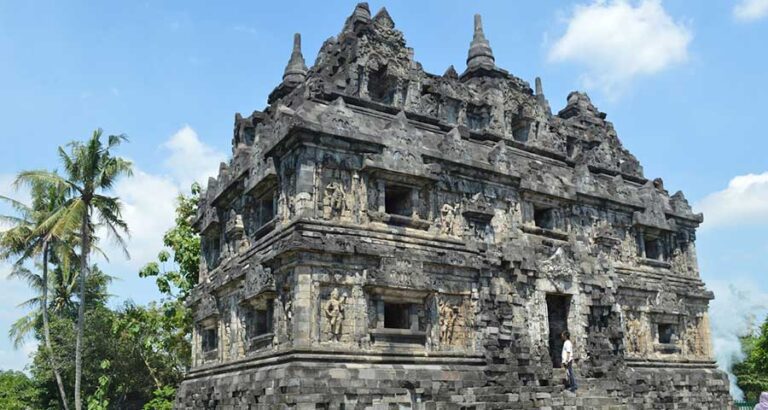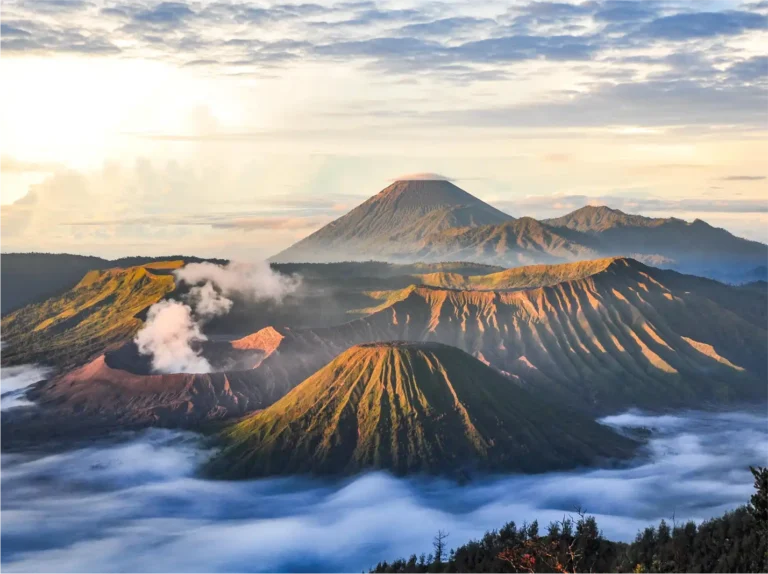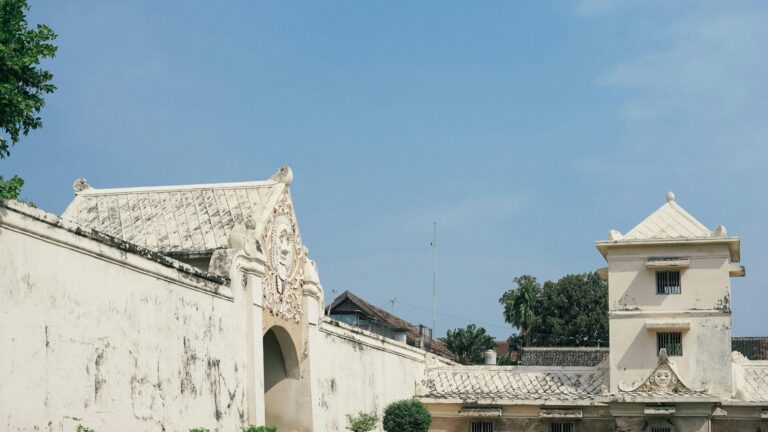Ratu Boko Site or Raja Baka Palace is an ancient site with remnants of various structures located approximately 3 km south of the Prambanan Temple complex, 18 km east of Yogyakarta City, or 50 km southwest of Surakarta City, Central Java.
It is more precisely situated in Bokoharjo village, Prambanan district, Sleman regency, Yogyakarta Special Region. The Ratu Boko Site is located on a hill at an elevation of 196 meters above sea level, covering an area of about 25 hectares.
This site exhibits features of a place for various activities, possibly a residential and royal dwelling site. Ratu Boko is estimated to have been in use since the 8th century during the Sailendra Dynasty (Rakai Panangkaran) of the Medang Kingdom (Mataram Hindu period).
The layout of the remaining structures strongly suggests that the site was a former royal palace rather than a religious temple, as it includes evidence of fortress walls and dry moats as defense structures. Remnants of a settlement for the local population have also been discovered around the site.
The name “Ratu Boko” originates” from the “local legend. Ratu Boko (Javanese, literally meaning “king stork”) is the “father of Loro Jonggrang, which is also the name of the main temple in the Prambanan Temple complex. This complex of buildings is associated with the local legend of Roro Jonggrang.
Read More: Discovering Prambanan 2024: Opening Hours, Admission, and Legend
History
Ratu Boko is located approximately 3 km south of Prambanan Temple. The Ratu Boko area is situated on a hill about 195.97 m above sea level.
Ratu Boko Site is not a temple but a kingdom’s ruins. Therefore, Ratu Boko Temple is often called the Ratu Boko Palace. It’s called Kraton because, according to legend, the site was the palace of Ratu Boko, the father of Lara Jonggrang.
It is estimated that the Ratu Boko site was built in the 8th century by the Sailendra Dynasty, which followed Buddhism but was later taken over by Hindu Mataram kings. This transition of ‘ownership’ influenced’ the Krat’n Boko buildings with both Hinduism and Buddhism.
A 792 AD inscription called the Abhayagiriwihara Inscription was found at the Ratu Boko site. The content of this inscription supports the assumption that Rakai Panangkaran built the Ratu Boko Palace.
The Abhayagiriwihara Inscription was written in the Pranagari script, one of the characteristics of Buddhist inscriptions. The inscription mentions that King Tejapurnama Panangkarana, believed to be Rakai Panangkaran, ordered the construction of Abhayagiri wihara.
The same name is also mentioned in the Kalasan Inscription (779 AD), Mantyasih Inscription (907 AD), and Wanua Tengah III Inscription (908 AD). The name that was finally settled upon, “Abhayagiri,” means “Fearless Mountain.”
Thu”, Abhayagiriwihara means a monastery built on a peaceful hill. During the rule of Rakai Walaing Pu Kombayoni, between 898 and 908, Abhayagiri Vihara was renamed Kraton Walaing.
The Ratu Boko Palace, which occupies a spacious land, consists of several buildings. Most of them are now just ruins.
Read More: Kalasan Temple: Unveiling the Oldest Buddhist Heritage in Yogyakarta
Ratu Boko Architecture
Unlike other ancient relics from the era of Ancient Java, which are mostly religious structures, the Ratu Boko site is a secular complex, complete with entrance gates, pavilions, residences, bathing pools, and protective walls.
In contrast to other Javanese palaces, usually built in relatively flat areas, the Ratu Boko site is located on a rather high hill.
High altitude makes constructing this complex relatively more challenging regarding labor and building materials. Unless the main building material, stone, is extracted from the hill. This naturally requires skilled workers to transform the rocky hill into blocks that can be used as construction material.
The elevated position also necessitates the presence of springs and a water management system to meet daily needs. The bathing pool is a remnant of this water management system, while the rest poses a challenge for archaeologists to reconstruct.
Being situated on a hill also provides cool air and beautiful natural scenery for its inhabitants, making the complex more difficult to attack by enemies.
Another special feature of this site is the area to the left of the gate, now commonly referred to as the “cremation place.” Its “ize and “position” n undoubtedly serve as a space to showcase something or an activity.
The name “cremation place” implies the necessity” of regular cremation” activities at this site, which requires further investigation. It might be worth exploring this area as an altar or offering place.
Ratu Boko, a World Heritage Site
The central government has now included the Ratu Boko Site complex in a special authority, along with the management of Borobudur Temple and Prambanan Temple under a state-owned enterprise called PT Taman Wisata Candi, after both of these temples were listed as UNESCO World Heritage Sites.
Consequently, the Ratu Boko Site has been redesigned in several areas to serve as an educational and cultural activity space.
Additional structures in front of the gate include a restaurant and an open space (Plaza Andrawina) that can be used for gatherings with a capacity of around 500 people, providing a vista towards the north (Prambanan Subdistrict and Mount Merapi).
Moreover, the management offers camping facilities, trekking, educational archaeology packages, and tour guides.
Ratu Boko Entrance Fees
The entrance fee for local tourists per person for one-time entry is
- Upper at age 10: Rp 40.000
- Age 3 to 10 years: Rp 20.000
Special rates for domestic tourists for student groups and university students per group for each entry* (with a letter of recommendation from the school/university).
- Minimum 20 people
Ratu Boko Entrance Fee: Rp 20,000
How to Get There?
The nearest major city to Ratu Boko is Yogyakarta. The Adisutjipto International Airport is popular with international tourists visiting Ratu Boko through Yogyakarta.
Access to Ratu Boko is facilitated by its proximity to Prambanan, which makes it convenient for those using public transportation from Yogyakarta.
-
For Yogyakarta Railway Station
From Tugu Railway Station, you can hop on Transjogja bus route 1A from Mangkubumi 1 bus stop. Get off the Prambanan Market bus stop and proceed to Ratu Boko using an ojek or taxi.
-
From Adisutjipto Airport
From Adisutjipto Airport, you can take the Trans Jogja bus route 1A to the Prambanan Market bus stop. From there, continue using an ojek or taxi to reach Ratu Boko.
-
Personal Vehicle
Ratu Boko can be accessed via Laksda Adisutjipto Street and the Solo – Yogya main road towards the east. At the Prambanan Market intersection, turn right (southward) towards Prambanan – Piyungan Street. Around 3 km from the intersection, signs will direct you to Kraton Ratu Boko on the left hillside.
Let’s Explore Java!
Let’s go unforgettable to Java, Indonesia, where a world of wonders awaits! Java, the heart and soul of Indonesia, is a treasure trove of diverse landscapes, rich cultural heritage, and breathtaking experiences.
Find out the package now from Yogyakarta Tours:
- 1 Day Tours:
- Multiday Tours
Author: Pramitha Chandra







